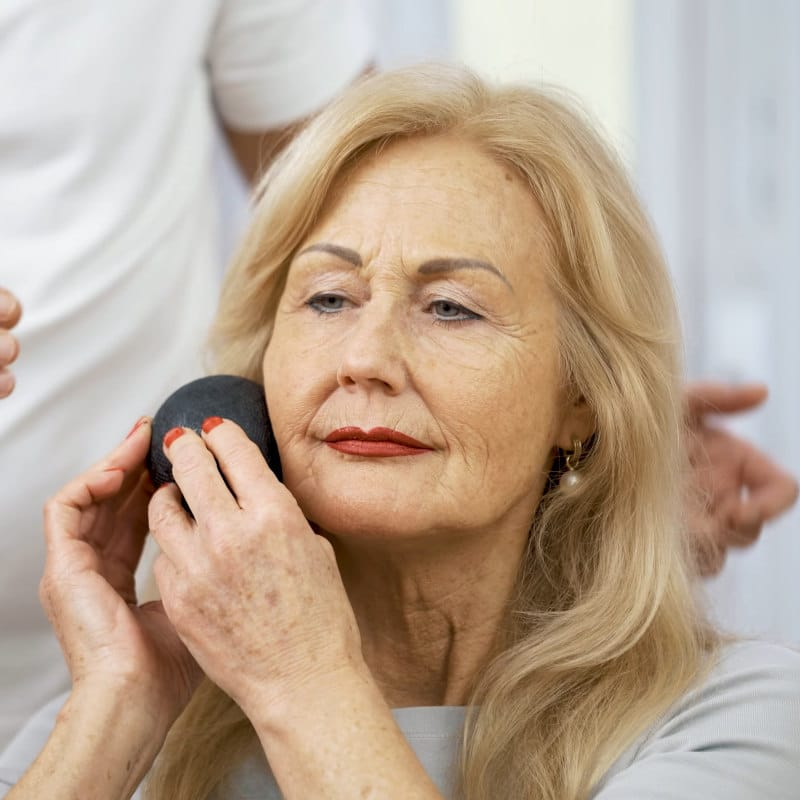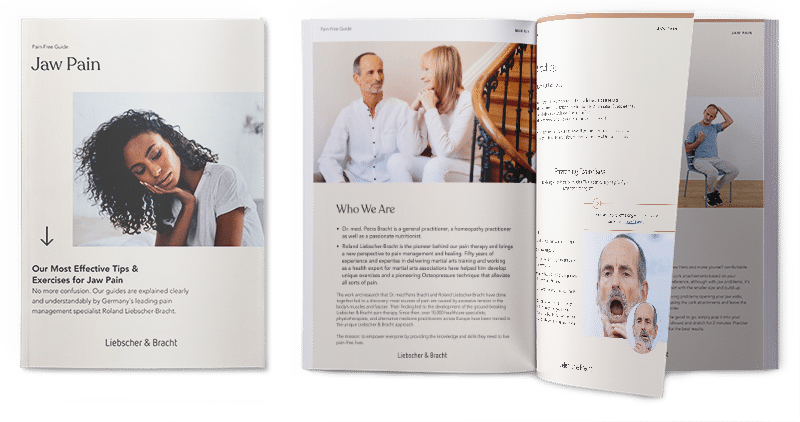jaw exercises
Body Part:
Jaw
Equipment:
Mini Massage Ball & The Jaw Hero
Level:
Intermediate
Body Part:
Jaw
Equipment:
Mini Massage Ball & The Jaw Hero
Level:
Intermediate
A tight jaw makes speaking, chewing, swallowing, and yawning difficult. (Your ears need that eye-watering yawn to pop when you’re at high altitudes.) These exercises can help. We’ve developed a routine that targets tight jaw muscles and fascia so you can relieve tension and pain and restore your range of motion. You’ll need our Mini Massage Ball and Jaw Hero. Use a tennis ball and a wine cork if you don’t have our tools. Jump to our routine if you’d like to start exercising, or keep reading to learn about your jaw joint and what could be causing the tightness.
Your jaw joints are called the temporomandibular joints. You have two temporomandibular joints, one on each side of your face just in front of your ears. The temporomandibular joints connect your lower jaw (the mandible) to your skull. These joints act like hinges; together with the surrounding muscles, the temporomandibular joints facilitate smooth movement of your jaw so it can open and close for breathing, speaking, chewing, and yawning. These essential functions can become painful if your jaw muscles and fascia are tight.
Your jaw may be tight because of the following:
Chronic stress and anxiety can lead to bruxism, a condition where you grind your teeth. (See below for more about bruxism.)
Temporomandibular joint disorder (TMD) is a general term for problems with the temporomandibular joint, the muscles you use to chew, and the surrounding bones and tissue. 1) TMD can be caused by malocclusion, which is an underbite, overbite, or crossbite. Additional causes include arthritis, a jaw injury, grinding or clenching your teeth, general wear and tear to the joint, and genetics.
Symptoms of TMD are fascial, neck, and shoulder pain. The pain may occur on one or both sides of your body. You may experience
a decreased range of motion, muscle stiffness, headaches, toothaches, and earaches. Your jaw may lock in one position or make a clicking or popping sound during movement.
Bruxism is when you involuntarily clench, grind, or gnash your teeth. The exact cause of bruxism is unclear. You may be at risk of developing bruxism if you suffer from anxiety, stress or have an aggressive personality. Bruxism may be aggravated by smoking, caffeine, alcohol, and some depression medications.
In addition to a tight jaw, you may have difficulty opening or closing your mouth or get headaches. Your tooth enamel may wear away, the tops of your teeth may flatten or chip, or your teeth may loosen, hurt, or feel sensitive.
Occlusion is how your teeth come together when you close your jaw. Malocclusion is when your teeth are out of alignment. A “bad bite” can be genetic or the result of thumb sucking or teeth that are too big. Signs that you have malocclusion are that your upper row of teeth juts out from your lower row of teeth (overbite), your lower row of teeth sits too far forward from your upper teeth (underbite), or your teeth do not come together when your mouth is closed (crossbite.) If you have a bad bite, chewing and biting may be difficult; it can lead to TMD (see above.)
Rheumatoid arthritis (RA) is an autoimmune disease, which means your immune system mistakenly attacks healthy body tissue. It’s not clear why RA develops. The condition causes joint inflammation, usually in the neck, hands, or feet. However, inflammation can occur in the jaw. Symptoms of rheumatoid arthritis in the jaw are pain on both sides of the jaw, tenderness and swelling, and limited range of motion and movements. 2)
Osteoarthritis in the jaw occurs when the cartilage covering the joints wears down. The condition has been linked to ageing and overuse of the joints. Symptoms of jaw osteoarthritis are inflammation, an ache or stabbing sensation when you move your jaw, joint stiffness or tenderness, or your jaw making noise. You may experience headache, neckache, tooth or fascial pain.
Also known as lockjaw, tetanus is a bacterial infection caused by Clostridium tetani. You may become infected with Clostridium tetani if you have an open wound (like a cut or burn) that makes contact with dirt or feces. Tetanus causes the jaw and neck muscle to spasms. If you think you have lockjaw, please see a doctor immediately.
Chewing food with a tough consistency or chewing gum for too long can tire your jaw muscles, resulting in soreness and tightness. The pain usually goes away in less than a day.
Visit our online shop to buy the Jaw Hero and Mini Massage Ball. While you’re there, take a look around. We’ve got lots of pain-relieving tools and products waiting to be added to your cart.
Take me to the shop.
You’ll need the Mini Massage Ball for this exercise.

You’ll need the Jaw Hero for this exercise. Choose cork attachments that will provide an intense, challenging stretch.
Add our jaw exercises to your daily routine. Practice once a day, six days a week and leave one day for rest. When your pain goes away, and your range of motion and ease of movement have returned to normal, you can adjust how often you exercise.
Download our FREE PDF guide and discover 6 effective exercises for getting rid of jaw pain.

Ease your jaw aches and pains, regain your range of motion, and loosen those stiff muscles around your mouth with these tmj exercises. Your jaw will drop.
Relieve TMJ PainAre you having difficulty opening your mouth all the way, chewing or talking because of lockjaw? Give our trismus exercises a try. Go from “Ahhh!” to “…ahhh…”
Try Our Lockjaw ExercisesA stiff neck is painful, but it’s an easy problem to solve. Our 3-step routine can help alleviate your neck pain and restore your range of motion.
Help Stiff Neck Now